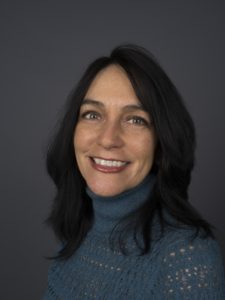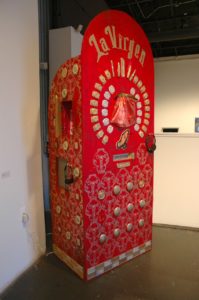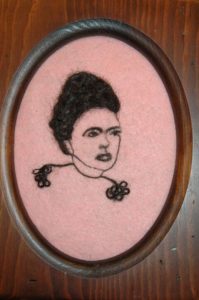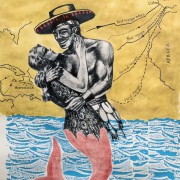Discovering Your Creative Voice: An interview with artist Tina Tavera
By Stephen Dupont, APR, vice president, Pocket Hercules
I know Maria Cristina “Tina” Tavera through my wife, Rebekah Dupont. Together, they work at Augsburg College; Tina oversees the TRIO-McNair Scholars Program and Rebekah runs the college’s STEM program. Both are strong believers in helping students of color and first-generation college students find the potential within themselves and carve clear paths toward graduate school or careers.
But that’s Tina, the college administrator.
I was first introduced to Tina, the Artist, when Rebekah and I visited a private showing of her work in South Minneapolis a few years ago. Tina’s art explodes off the walls. In the collection we viewed, consisting primarily of prints, she brought together a vibrant mix of cultural references framed within the context of her Mexican heritage.
The focus of this interview is to learn more about how Tina balances all of this – her work in helping college students secure graduate studies, her commitments as a wife and parent, and her impressive, and varied, artistic productivity. I know there are many who will read this who struggle daily with balancing gifts and passions within themselves. I hope Tina’s story sheds some light on how you can live the life you desire.
Stephen: How did you get your start as a professional artist?
Tina: I’ve always been creative. I experimented with art while in college. But it wasn’t until after the birth of my first child that I turned to art as a means to process the significance of being a parent. I think it was a response to moments I became overwhelmed by all of the mundane aspects of child rearing, and the frustrations of being home with small children. That’s when I returned to art.
Stephen: When was your first show?
Tina: My first show was called “Day of the Dead.” The art was created while I was about eight to nine months pregnant with my son in 1998. And I built the installation when he was a month old.

Photo credit: Xavier Tavera
Stephen: Are there other artists in your family?
Tina: Yes, there’s actually a long line of artists in my family, and my husband, Xavier Tavera, is an artist and photographer. My children are artists as well.
Stephen: How did you discover your voice as an artist?
Tina: I’ve always been drawn to art. When I was younger I spent a lot of time doodling. I never intended to make a career as an artist. I just started to create art because I had something I needed to say, especially around the theme of women and culture. Eventually, I felt comfortable in making the shift from doing art for myself to creating art for others to understand.
It wasn’t easy. Many artists – many people – discredit their creativity. They talk themselves out of sharing their voice with others.
Stephen: Did you have any concerns about finding your creative voice?
Tina: Yes. When people start to consider themselves as artists, they often think that they must create a signature look. I used to think that myself. But I’ve let go of worrying about how the final product will resemble prior works as the concern started to obstruct my productivity. Now, I focus on what I want to say and then I explore different mediums and visuals that can help me say it. That’s why my work bounces from one medium to another. I rely on the repetition of topics I address to tie the work together.
Stephen: How do you work? Do you dedicate time each day to work on your art, or does it come in surges?
Tina: Well…what I tend to do is set a date. I’ll set a date for an exhibition, and once I have that date, I know I must create new work for it. When I have to focus, I sometimes need to let the other daily responsibilities in my life go for a while so I can prepare for that exhibition.
Stephen: What drives your creativity?
Tina: Often times, it’s an external factor or force. For example, I had several friends turning 40 who were really struggling with fertility. They were feeling all this pressure – pressure they placed on themselves, pressure from their spouses, pressure from their families. Some were praying for a child. Some were not. As I observed their biological clocks ticking, I felt this need to express it. The result was “Conception/Anti-Conception Center” for the 2011 El Milagro (The Miracle) exhibition at Intermedia Arts in Minneapolis.

In a way, I’m like a hockey mom but my life is full of art. In our free time, me, Xavier and our kids are always going to art exhibitions. I’m thinking about art all of the time. I have ideas swirling in my head, and what I do is make lists of my ideas. Xavier, who is a photographer, says to me: “You must produce!” But I’m not like a Picasso who can paint a thousand paintings. That’s why I give myself a deadline. And I know that I must give up other things to meet the deadline of a show.
Stephen: Do you have a specific process that you follow when you create art?
Tina: I try to do something every day. Sometimes that means getting up early and working for an hour or so before I go to work at Augsburg College, where I oversee the McNair Scholars program. On a day in which I have a tighter schedule – one that does not allow me to produce art — I may work on a task that requires less time such as updating my CV or organizing files of my artwork. One thing is that I have to feel really organized. But I don’t allow that to interfere with the creative process. The artmaking process is about things going wrong from time to time.
Going back to the deadline. When I’m on it, it’s literally about all I can think of. As the deadline approaches, Xavier is supportive to take care of our home.
Stephen: How do you balance your life as an artist with your life as a college administrator, as a parent, a spouse, and at times, as I understand it, as a community activist?
Tina: Sometimes I feel that the roles intertwine. I try to be informed and active in my community where I live. However my activism is probably more so in my profession where we create programming to help equalize access to education for those who are less advantaged because of income or race. And interrelated, my most recent artwork addresses the topic of classifications of race.
Stephen: Do you find that you prefer one medium over another, such as painting over printmaking?
Tina: That’s a hard question because I’m so restless. I also think that the medium I choose depends on what I am trying to communicate. Lately, I have been focusing on printmaking.

Stephen: Your husband Xavier is a professional photographer. How does having another artist in the home help or hurt your own creative process?
Tina: It can be stressful when we both have deadlines around the same time. But Xavier is the person I most often ask for advice to resolve issues related to a project. Xavier is very reflective and often provides insightful feedback regarding aesthetics and iconography. I also appreciate that I can ask him about the controversial artwork: How do you think this would be perceived? Is the work portraying what I am trying to communicate?
Stephen: Which piece of work are you most proud of, so far?
Tina: I had an exhibit titled “Reconfiguring Casta” in the Christiansen Gallery at Augsburg College. I am excited about the work and there will be a similar installation combined with some new work titled “Un-typing Casta” at the Tweed Museum in Duluth from November 8, 2016 to January 29, 2017.
Stephen: How have your children influenced your art?
Tina: My children have made it possible for me to be an artist. They have grown up in the galleries sitting through long meetings and eating art-opening food. The first time my daughter wrote her name it was in pen in large letters on a freshly painted white vitrine. They are my inspiration as my art often addresses gender and cultural roles as I think a lot about how language, traditions, and customs are passed from generation to generation.
Stephen: Your art reflects the crosscurrents of your Mexican heritage and your life in the United States. What do you think other cultures can learn from your art? For example, for the person who identifies as Irish-American or the Hmong-American, is there a core message that they can relate to?
Tina: Funny! I actually am Mexican-Irish. I find it fascinating how things are catego

rized by race, ethnicity or gender. For instance, hip hop started in the South Bronx with Blacks and Puerto Ricans in New York, but most people do not associate the music with Latinos. And yet, now that the music is so popular many people view it as mainstream culture. So how do some things meld to become “American” and others remain on the margins? Or, for instance, I overheard some Mexican women
commenting how they associated the Mexican painter Frida Kahlo’s bushy eyebrows with her lesbian tendencies. As if the eyebrows determined her sexual preferences. The notion seems a little preposterous but then I realized similarly many in the U.S. associate hairy legs or hairy armpits with masculinity. The concept of physical traits being tied to sexual preference, gender, or ethnicity has become a recurring theme in my artwork such as a silhouette made out of my pubic hair of the Mexican painter Frida Kahlo.
Stephen: Do you feel your art has the power to transform a person’s life? When you create your work, are you seeking a specific type of transformation or understanding?
Tina: I just hope my art can help encourage some much needed conversations about some challenging topics our society is currently confronting.
Stephen: Do you have any advice for a young person who aspires to create art? Possibly, to make a career and lifestyle as an artist?
Tina: As a profession it is very competitive, unstable and often not lucrative. However creating art can benefit you mentally, spiritually and physically. You don’t always need a lot of resources to do art. I have learned some helpful artistic skills and tips from YouTube videos. Seeing what other artists are creating also is inspirational. Most art galleries and many museums are free. I believe that everyone is creative. You don’t have to be young to start making art. By exploring your creativity you can be a better problem-solver no matter what you do professionally.

Stephen: Do you think your 17-year-old self would be proud of who you’ve become?
Tina: I think so. A lot of people quit art, whether that’s playing in a band or doing what I do, when they become parents. I’ve continued even when it was hard to do with all of my other responsibilities. The other thing that I think is most important is an artist should not feel threatened in sharing their work with others. I think my 17-year-old-self would be proud to see me doing that.
Stephen: For many artists, exhibiting their work is that moment when they put themselves out there. What does that feel like for you?
Tina: I enjoy that moment. And I have to say, its kind of downer when it’s all over. To me, it’s like a wedding day or any other major event, and there are so many emotions that go with it. It is also can be exhausting so there have been some times when I have said to myself, “I’ll never exhibit again!”
There’s also a difference between a solo show when I’m exhibiting just my pieces, and a group show where a theme has been selected around which the artists create their work. In a group show, I feel your art is looked at in relation to the other artists, and to me, I think that’s the intent – the kinetic energy that the artists create together. Group shows can easily generate larger audiences and contribute to new audiences reacting to and experiencing your art. Having someone else select them has really stretched me as an artist.
Artists always appreciate when people attend their exhibits to see what they are creating. Take for example the exhibit El Milagro at Intermedia Arts that featured my piece, “Conception / Anti-Conception Center.” While I was there, I noticed a woman standing for a long time observing my piece. I had to ask her why. It turned out that she was an OB/GYN nurse. She was very moved by it and responded that she was going to bring other nurses to see it. She also said her youngest client was 11 and her oldest was 54 years old. I was so excited that someone in the health profession who thinks daily about pregnancy connected with my artwork.
Stephen: Where can our readers learn more about your art?
Tina: I would start by looking at my profile with MNArtists.org. Here are two good links:
http://www.mnartists.org/community?global_search=Maria+Cristina+tavera
http://www.mnartists.org/user/5440
Stephen Dupont, APR, is VP of Public Relations and Branded Content for Pocket Hercules (www.pockethercules.com), a brand marketing firm based in Minneapolis. Contact Stephen Dupont at www.linkedin.com/in/stephendupont or visit stephendupont.co.